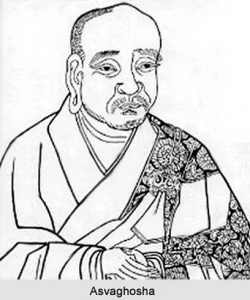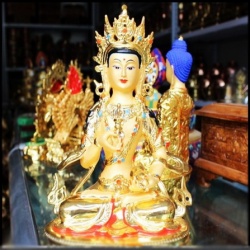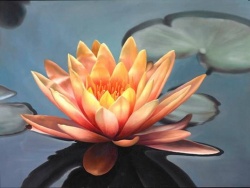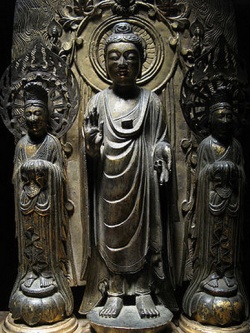Aśvaghoṣa
Aśvaghoṣa, whose name means ‘horse’s voice,’ was one of India’s greatest poets. He was born in Sāketa in the 2nd century CE, he converted to Buddhism in his youth, and became court poet to King Kaniṣka. The Buddha’s teachings had by then brought about a revolution in Indian religious and philosophical thought, as well as in the arts too. Within 500 years of the Buddha’s passing,
Buddhists were using all the visual and literary arts to draw people towards the Dhamma, explain it to them and awaken their faith. Aśvaghoṣa epitomised this movement. He wrote the Saundarānandakāvya, a poem retelling the conversion of the Buddha’s cousin Nanda;
the Sāriputraprakaraṇa, a play in nine acts about the life of Sāriputta; the Gaṇḍistotra, a charming eulogy to the monastery bell and the Vajrasuci, a detailed critique of the Hindu caste system. But Aśvaghoṣa’s most famous work was the Buddhacarita, a retelling of the life of the Buddha, which had a profound effect on the cultured class and later influenced a many great Sanskrit poets.
Famous non-Buddhist yogi in India in Nagarjuna's time. Mentioned in Taranatha's rise of Buddhism in India chos 'byung. Almost defeated the monks at Nalanda in debate so they sent a message to Nagarjuna requesting help. Nagarjuna sent his disciple Aryadeva to debate with the Indian heretic. The heretic was defeated but refused to accept Buddhism so they locked him in the library. Slowly he began to read the books and one day realized that Lord Buddha's dharma was authentic. He took refuge and wrote many famous texts.
Aśvaghoṣa (Devanagari: अश्वघोष) (c. 80 – c. 150 CE) was an Indian philosopher-poet, born in Saketa in northern India to a Brahmin family. He is believed to have been the first Sanskrit dramatist, and is considered the greatest Indian poet prior to Kālidāsa. He was the most famous in a group of Buddhist court writers, whose epics rivaled the contemporary Ramayana. Whereas much of Buddhist literature prior to the time of Aśvaghoṣa had been composed in Buddhist Hybrid Sanskrit, Aśvaghoṣa wrote in Classical Sanskrit.
Life as an ascetic
According to the traditional biography of Aśvaghoṣa, which was translated into Chinese by Kumārajīva, and preserved in that language, he was originally a wandering ascetic who was able to defeat all-comers in debate.
He set a challenge to the Buddhist monks that if none could meet with him in debate then they should stop beating the wood-block which signalled to the people to bring offerings to them. There was no one there to meet the challenge so they stopped beating the wood-block.
However, in the north there was an elder bhikṣu named Pārśva at the time, who saw that if he could convert this ascetic, it would be a great asset to the propagation of the Dharma, so he traveled from northern India, and had the wood-block sounded.
The ascetic came to ask why it had been sounded and though thinking the old monk would be unable to debate with him, he accepted his challenge, and after seven days the debate was held in front of the King, his Ministers, and many ascetics and brahmans. The loser agreed to become the disciple of the other.
They agreed that the elder Pārśva should speak first, and he said: "The world should be made peaceable, with a long-lived king, plentiful harvests, and joy throughout the land, with none of the myriad calamities", to which the ascetic had no response and so was bound to become Pārśva's disciple, and he was given full ordination as a bhikṣu.
Although he had to consent to this, he still wasn't convinced of the elder's virtues until he showed him he had mastered the Bases of Spiritual Power (r̥ddhipādāḥ), at which point he gained faith. Pārśva then taught him the 5 Faculties, the 5 Powers, the 7 Factors and the 8-fold Noble Path and he eventually mastered the teaching.
Later the central kingdom was besieged by the Kuṣān King's army, who demanded 300,000 gold pieces in tribute. The King could not pay so much as he had only 100,000. The Kuṣāna King therefore asked for the Buddha's begging bowl, the converted monk and the 100,000 gold pieces for his tribute.
Although the King of the central kingdom was unhappy, the monk persuaded him it would be for the good of the propagation of the Dharma which would spread across the four continents if he went with the Kuṣāna King. He was therefore taken away.
The Kuṣāna's King's Ministers however, were unhappy, not thinking that the bhikṣu was priced correctly at 100,000 gold pieces. The King, who knew his worth, ordered that seven horses be starved for six days, then he made an assembly and had the bhikṣu preach the Dharma.
Even the horses, whose favorite food was placed in front of them, were entranced by the Teaching of the monk, and listened intently. Everybody was thereby convinced of his worth, and he then gained the name Aśvaghoṣa, Horse-Cry.
He traveled throughout northern India proclaiming the Dharma and guiding all through his wisdom and understanding, and he was held in great regard by the four-fold assembly, who knew him as The Sun of Merit and Virtue.
Written works
He was previously believed to have been the author of the influential Buddhist text Awakening of Mahayana Faith, but modern scholars agree that the text was composed in China. And it is now believed he was not from the Mahayanist period, and seems to have been ordained into a subsect of the Mahasanghikas.
He wrote an epic life of the Buddha called Buddhacarita (Acts of the Buddha) in Sanskrit. I-tsing (Yijing) mentioned that in his time Buddhacarita was "...extensively read in all the five parts of India and in the countries of the South Sea (Sumātra, Jāva and the neighbouring islands). He clothed manifold notions and ideas in a few words which so delighted the heart of his reader that he never wearied of perusing the poem. Moreover it was regarded as a virtue to read it in as much as it contained the noble doctrine in a neat compact form."
It described in 28 chapters the whole Life of the Buddha from his birth until his entry into Parinirvāna, but during the Muslim invasions of the 10th - 12th centuries half of the original text was lost in Sanskrit, and today the second half only exists in Chinese and Tibetan translations.
He also wrote Saundaranandakavya, a kāvya poem with the theme of conversion of Nanda, Buddha’s half-brother, so that he might reach salvation. The first half of the work describes Nanda’s life, and the second half of the work describes Buddhist doctrines and ascetic practices.
Source
Wikipedia:Aśvaghoṣa
klu sgrub kyi thugs sras bdun - The seven spiritual sons of Nagarjuna.
1) {shA kya mi tra}. Sakyamitra.
2) {nA ga bo dhi}. Nagabodhi
3) 'phags pa lha}. Aryadeva
4) {ma tang ki}. Matangi
5) {sangs rgyas bskyangs}. Buddhapalita
6) {legs ldan 'byed}. Bhavaviveka
7) {slob dpon dpa' bo}. Ashvagosha [RY]
rta dbyangs - chant, hymn, chanting, Ashvagosha [RY]
thub dka' - 1) hard to defeat; 2) Ashvagosha/ rta dbyangs [IW]
dpa' bo - 1) courageous person [syn: gyad mi dang, 'jigs med, nyam nga med, snying stobs can, bsnyengs bral, gtum pa'i dpung pa can, stobs chen, brtul phod pa, thal byung 'gro, rnam gnon can, pha rol gnon, bag mi tsa, mi 'gong ba, tsom pa med, zhum pa mi mnga' zhe sdang ldan, g.yul ngor brtan, g.yul na brjid];
2) Ashvagosha [one of the 'phags yul gyi chen po bzhi slob dpon dpa' bo, in W India yab bram ze che'i rig byed yan lag brgyad la byang chub pa son of the great physician seng ge gsang ba &,
his consort rin chen dngos grub, from the time he was small studied the vedas &, rig byed kyi yan lag bzhi, nye ba'i yan lag bzhi, las drug etc., esp medicine,
later became buddhist, named rta dbyangs, mu stegs rtag pa smra ba'i lugs la mkhas par gyur nas W buddhist pandits dang brtzad pas rta dbyangs rgyal te nang pa'i bstan pa bsnubs nas phyi pa'i lugs su bsgyur and lho phyogs su rtzod par phebs pa las, student of Nagarjuna Aryadeva, rta dbyangs dang phyi nang gi doctrines rtzod par phebs nas rta dbyangs was defeated and became buddhist, phyis su dpal mgon klu sgrub yab sras kyi slob ma, [IW]
dpa' bo - 1) courageous person, daka, hero[ic], v ra, warrior; 2) Ashvagosha [IW]
bla ma lnga bcu pa - Fifty Verses on Devotion to the Master, by Ashvagosha, (T 3721) [RY]
dbyug pa can -
1) Dandi;
2) Ashvagosha;
3) nyi ma'i 'khor;
4) lord of death;
5) carrying a stick/ club [IW]
dbyug pa can - 1) Dandi [7th century S India brahmin master: previous snyan ngag shastras abridged as snyan ngag me long];
2) Ashvagosha;
3) nyi ma'i 'khor;
4) lord of death [IW]
slob dpon dpa' bo - Ashvagosha [RY]
He is also thought to be the author of the Mahālaṅkāra (Great Ornament).
See also
Asvaghosa and His Times,Sarla Khosla, 1986.



